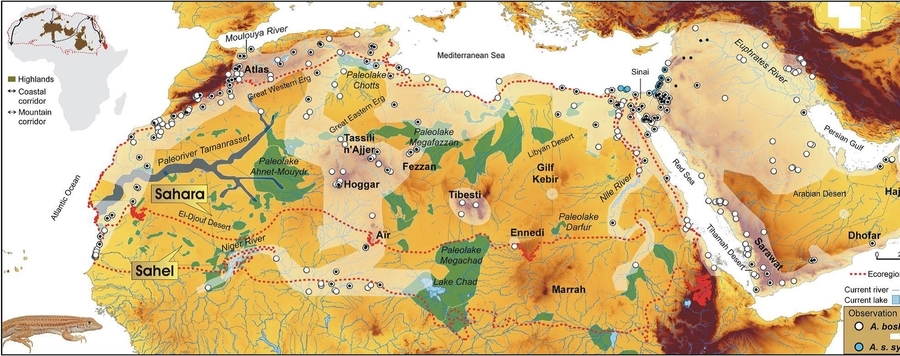
The role of Sahara highlands in the diversification and desert colonization of the Bosc's fringe-toed lizard
Aim: The biogeographic history of the Sahara-Sahel desert is tightly linked to its extreme and fluctuating palaeoclimate and diverse topography. For the mesic species inhabiting the region, coastal areas and the Nile Valley are perceived as the main pathways to disperse through desert habitats, but past connections may have also occurred throughout currently isolated mountain regions. Herein, we test the trans-Sahara mountain corridor hypothesis (i.e., mesic connectivity across Central Sahara highlands) and its role in the diversification of a small terrestrial vertebrate. Location: North Africa and Arabia. Taxon: Acanthodactylus boskianus (Squamata: Lacertidae). Methods: We integrated multi-locus mitochondrial and nuclear phylogenies with species’ climate-niche modelling, including palaeo-projections. Genetic analyses aimed to assess the species’ genetic structure, identify its main mitochondrial lineages and nuclear diversity, and reconstruct its ancestral biogeography. Species’ climate-niche stability was modelled independently for the Late Pleistocene- Holocene and the Plio-Pleistocene, to infer historical climatic refugia and dispersal corridors. Results: Four spatially structured mitochondrial lineages, integrating several parapatric sub-lineages, originated during the Plio-Pleistocene. Nuclear data revealed nine potential candidate species. Climatic refugia were located in mountains and desert fringes, remaining consistent for the Late Pleistocene-Holocene and the Plio-Pleistocene. Recurrent North-South climatic corridors were located along the desert periphery, while others less frequent were found across Central Sahara. Ancestral biogeography analyses recovered a recent Pleistocene colonization of the Sahel throughout eastern Sahara and either Sahara or Sahel origin for Central Sahara populations. Main conclusions: Species’ diversification was triggered by a combination of Plio-Pleistocene climatic cycles across a complex topographic region, where mountains acted as the main diversification hotspots. The historical role of Central Sahara highlands as main non-peripheral mesic refugia was corroborated. In addition, intermittent climatic connections linked Mediterranean and Sahel ecoregions with Central Sahara refugia, suggesting the existence of alternative trans-Sahara dispersal routes to the putative coastal and Nile corridors.






